Genetics Exam 4 (Final)
1/45
There's no tags or description
Looks like no tags are added yet.
Name | Mastery | Learn | Test | Matching | Spaced |
|---|
No study sessions yet.
46 Terms
Levels of DNA Organization
DNA 🡪 Nucleosomes - DNA on Histones 🡪 chromatin - DNA combined with histones and non-histone proteins 🡪 chromatid 🡪 chromosome
Processes Affecting Transcription
Histone modification, DNA methylation, dosage compensation, promoters, enhancers, silencers, transcription factors
Processes Affecting Translation
(pre translation -- pre mRNA censoring, alternative splicing, polyA tail length) Selective inhibition, microRNA action, cytoplasmic localization (post translational -- folding, bind subunit, modification chemical, shape, length)
Epigenetics
heritable changes in gene expression that do not involve changes to the DNA sequence --> epigenator like stress sends signal to initiators (protein or non-coding RNA) that identify where the sequence is modified which is then modulated by maintainers like DNA methylases, histone acetylases, histone deacetylases
Factors impacting phenotype expression
Chromatin modification, dosage comp, allele interaction, gene interaction/epistasis, environment, organelle inheritance
Chromatin Remodeling
on top of the DNA not in sequence; complexes bind directly to DNA sites and reposition nucleosomes changing access to DNA; Loosens or closes the histone-DNA complex to allow or block transcription factor access to DNA
Histone Modification
Addition of methyl groups to histone protein tails and/or addition of acetyl groups to histone protein tails -- acetylation makes DNA more accessible by changing the wrapping around histones --> transcription factors may bind to DNA (can both activate and repress genes)
DNA Methylation
The addition of methyl groups to cytosine bases adjacent to guanine nucleotides (CpG)-CpG islands --> usually associated with decreased gene expression (represses genes) --> methylated CpG island means promoter is methylated and the gene is turned off
Environment and Epigenetics
diet, exercise, psychological state, disease exposure, etc. can cause epigenetic modifications by influencing chemical levels which can result in histone modification or DNA methylation (turning genes on or off) which is passed down to offspring
Epigenetic Effects
changes induced by maternal behavior, effects caused by prenatal exposure, effects in monozygotic twins over time
Disease and Epigenetics
hypermethylation can inactivate genes improperly causing disease, turn on or off gene --> may create disease, epigenetic changes found in Alzheimers, Huntingtons, and schizophrenia
Mice Epigenetics Examples
Mice --> high parental care releases serotonin which activates histone acetylase leading to histone demethylation allowing the glucocorticoid receptor to be expressed resulting in low anxiety and low corticosterone levels -- removing methylation allowed for beneficial gene expression; diet rich with methyl donor supplements results in normal brown pups even if mother is unhealthy -- methylation silences harmful gene
Epigenetic Disease Examples
(note non coding RNA also has epigenetic effects as it can essentially bind at any point in the replication process and effect the outcome) Hypertension - histone modification, vascular calcification - DNA methylation, histone modification, non-coding RNA (there are some epigenetic drugs available)
Codominance
hets fully express both alleles; e.g. human blood AB
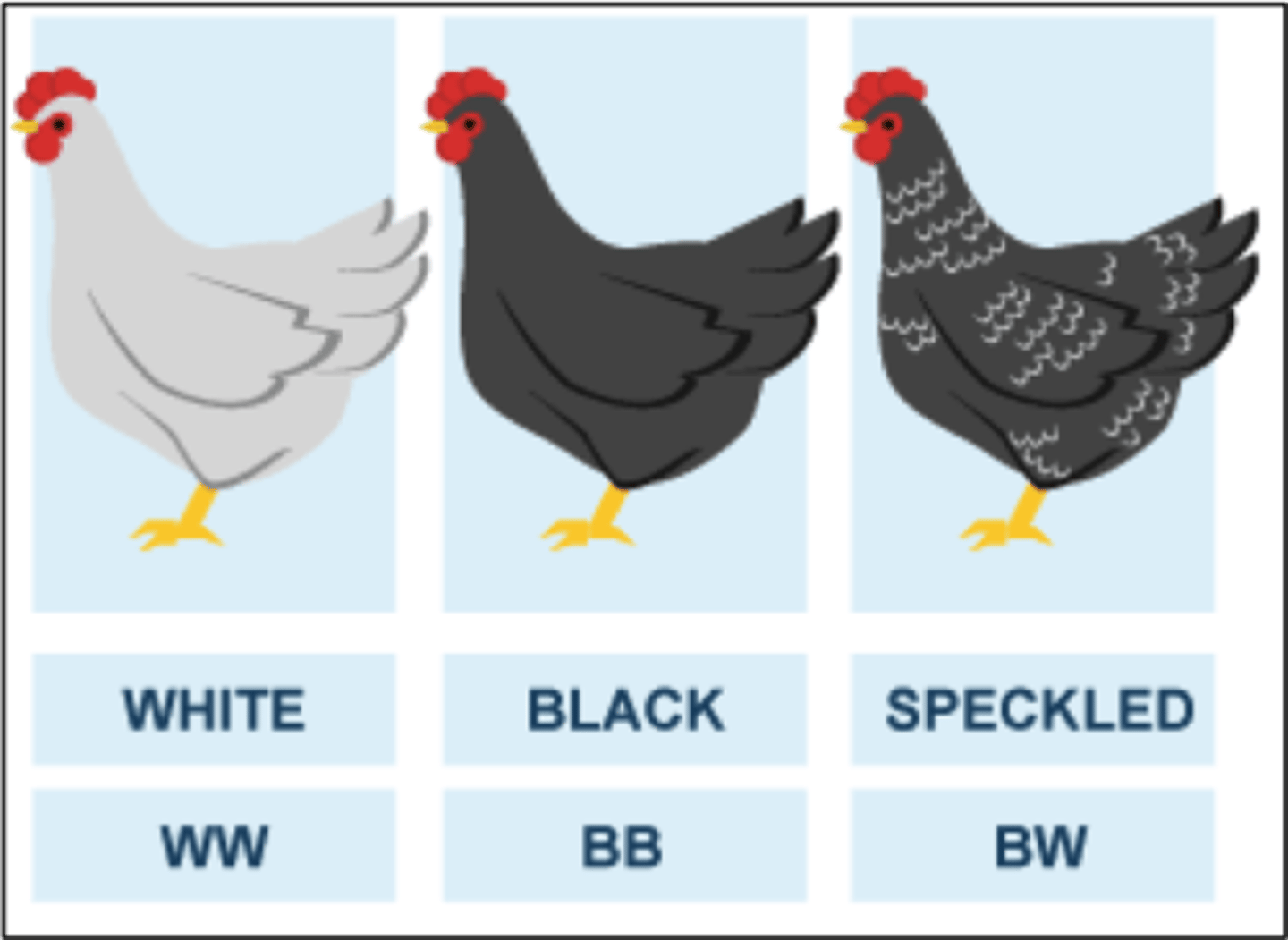
Incomplete Dominance
The offspring show a phenotype intermediate between the two of the parents -- red x white flower results in pink and pink x pink results in all three colors (1/2 pink)
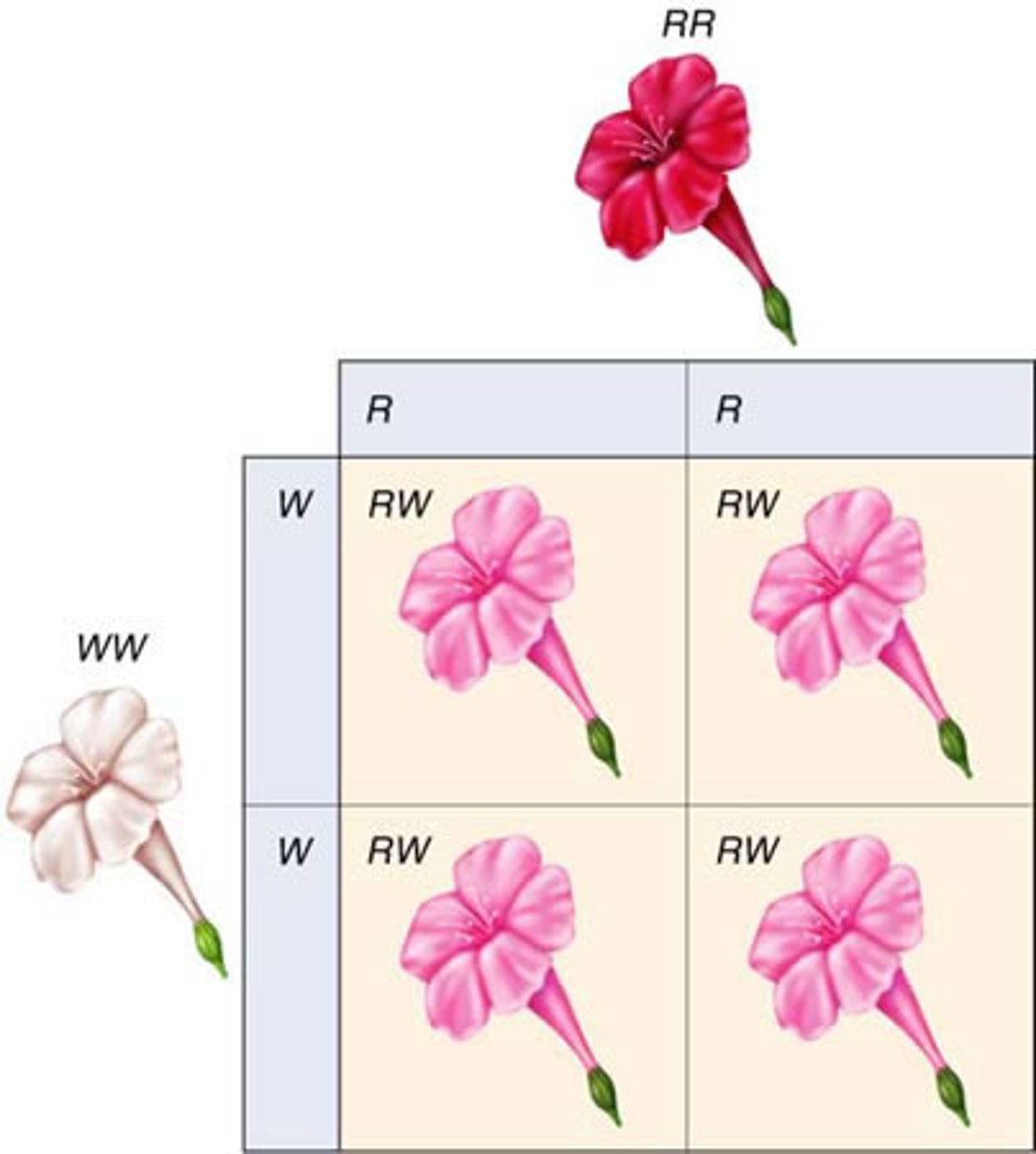
Variable Expressivity
A range of phenotypes seen with the same genotype; the degree to which a genotype is expressed as a phenotype within an individual -- varying levels of phenotype results e.g. shades from red to pink to yellow to white
Incomplete Penetrance
a percentage of individuals with a genotype fail to express the phenotype; likelihood that a person with a particular genotype will express the associated phenotype -- complete penetrance is 100% expression
Polydactyl
incomplete penetrance and variable expressivity -- extra or partial extra digits; not everyone who carries the trait manifests it; there is varying levels of manifestation including number and toatality of digits
Epistasis
One gene's expression affects the phenotypic expression of a second gene -- the control is 9:3:3:1 with no epistasis --> epistasis ratios all add up to 16 - 9:7, 1:15, 12:3:1
Complementary Gene Action
need a functional copy of both genes to get the trait; e.g. corn - one or both genes have the recessive allele resulting in white corn if one dominanat allele is present in either gene the result is purple - 9 purple:7 white
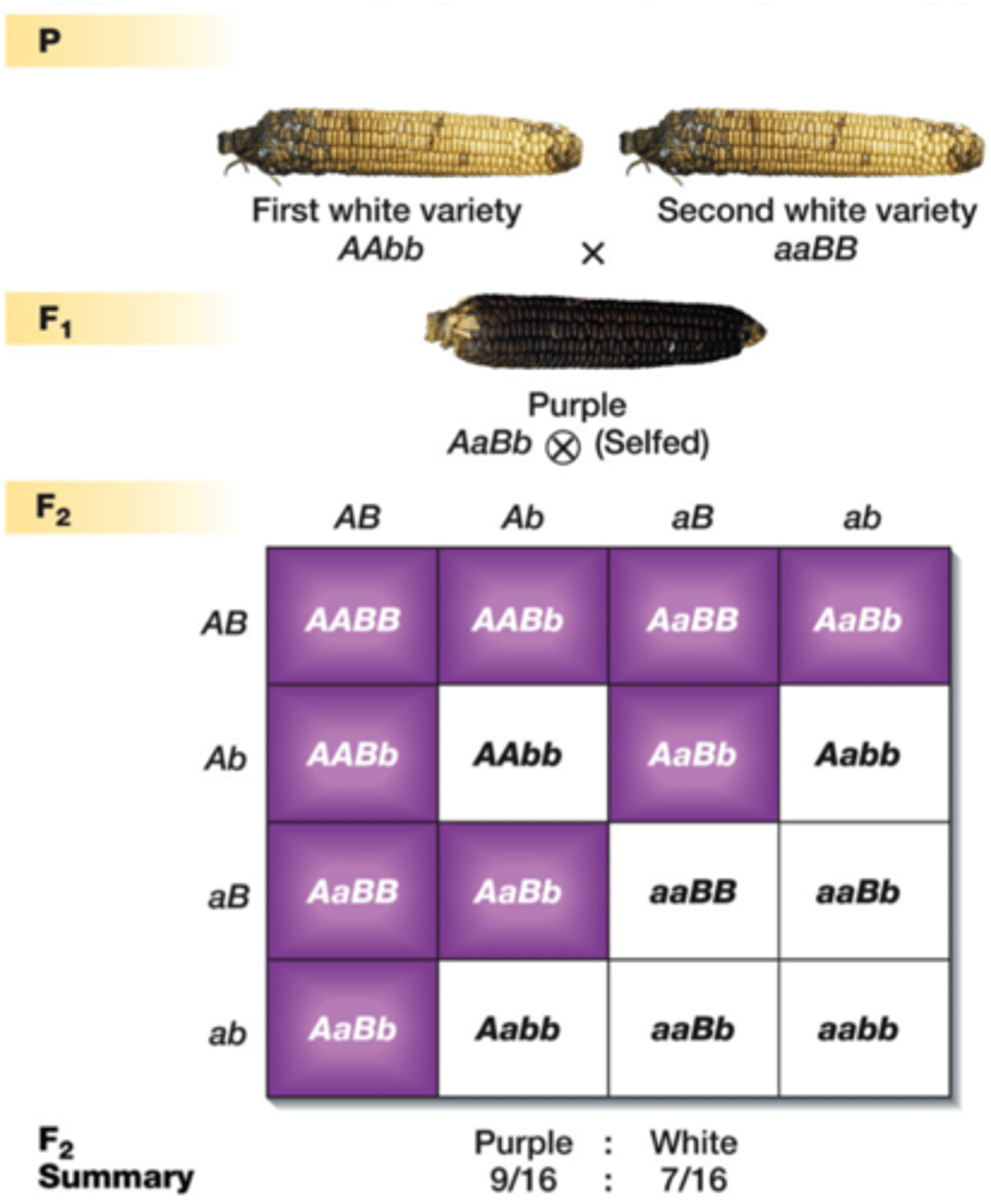
Duplicate Gene Action
two genes produce a phenotype with both genes appearing to be equivalent; trait is seen if at least one functional allele is present - 15:1 (e.g. biochemical pathway - allele codes for enzyme that results in shape so only one is needed to get shape)
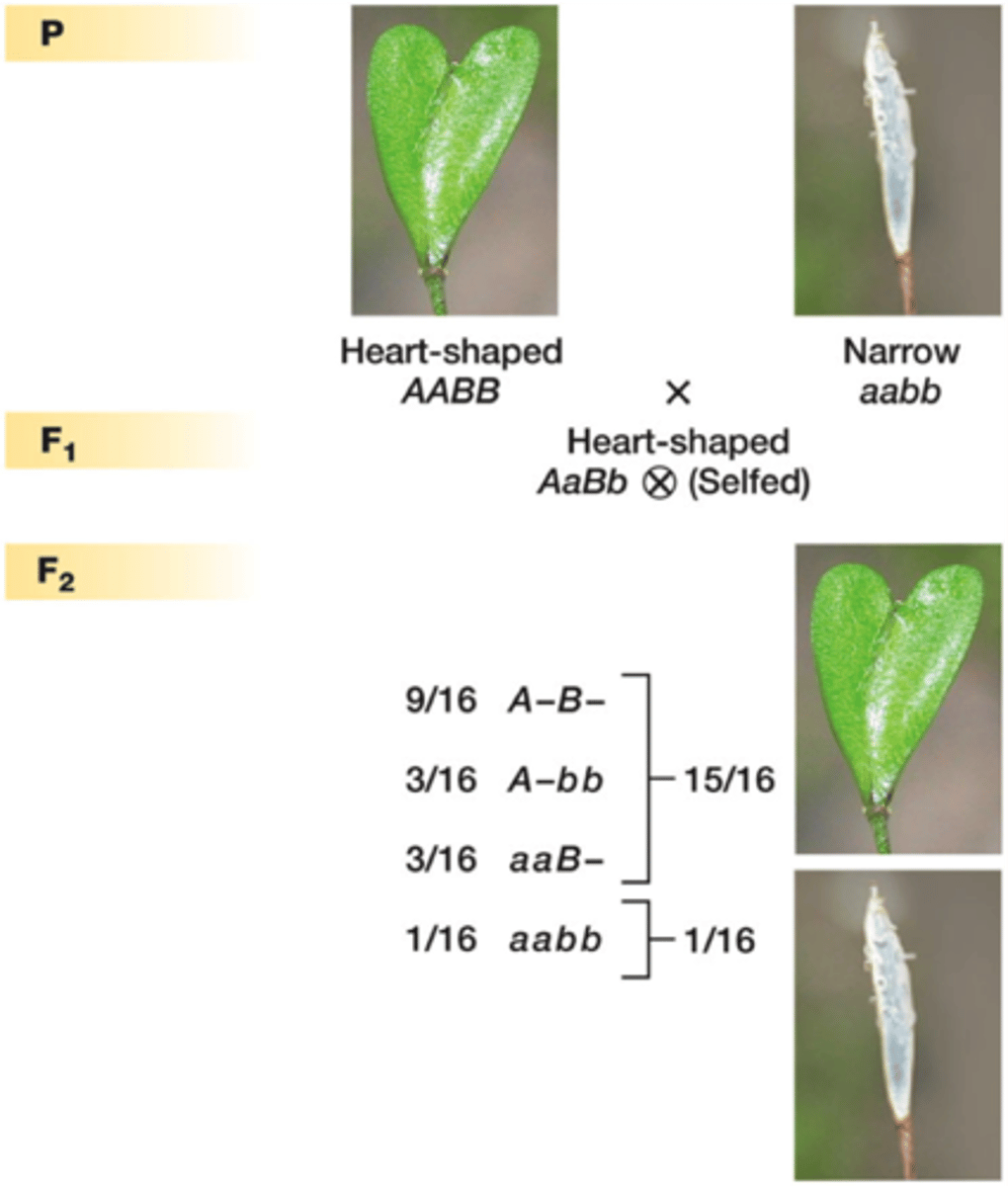
Recessive Epistasis
only the homozygous recessive genotype of one gene masks the expression of the second gene; e.g. if ee is present then the color is yellow regardless of B or b, ee masks the expression of the other gene; 9:3:4
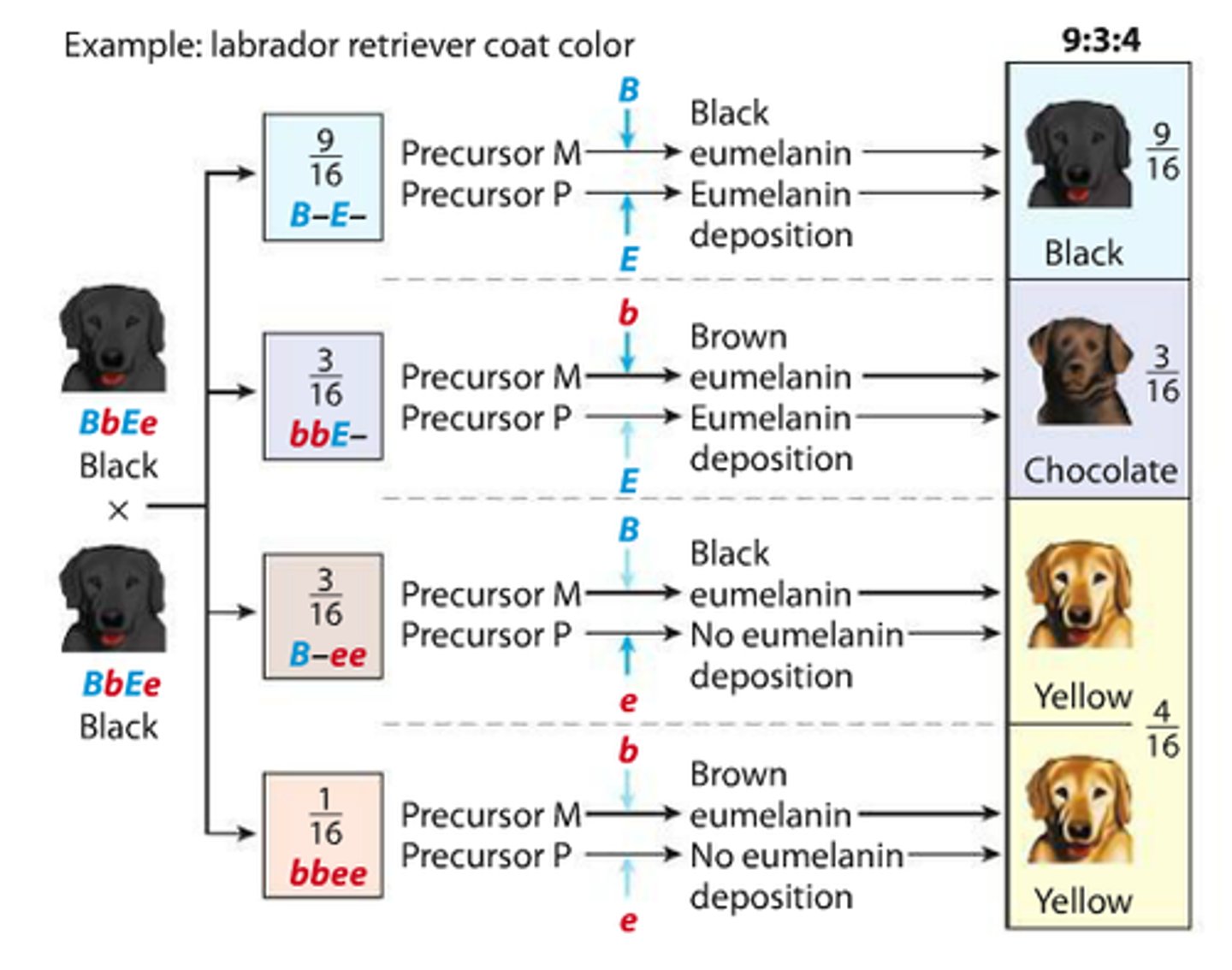
Dominant Epistasis
dominant allele of one gene affects expression of all alleles of second gene; e.g. if the dominant white allele is present the flower will be white regardless of the red allele, pink only appears when both genes are recessive; 12:3:1

Dominant Suppression
dominant allele of one gene suppresses the dominant allele of another gene --> one allele codes an inhibitor which if present as ii with cc or I with C/c affects the color; 13:3
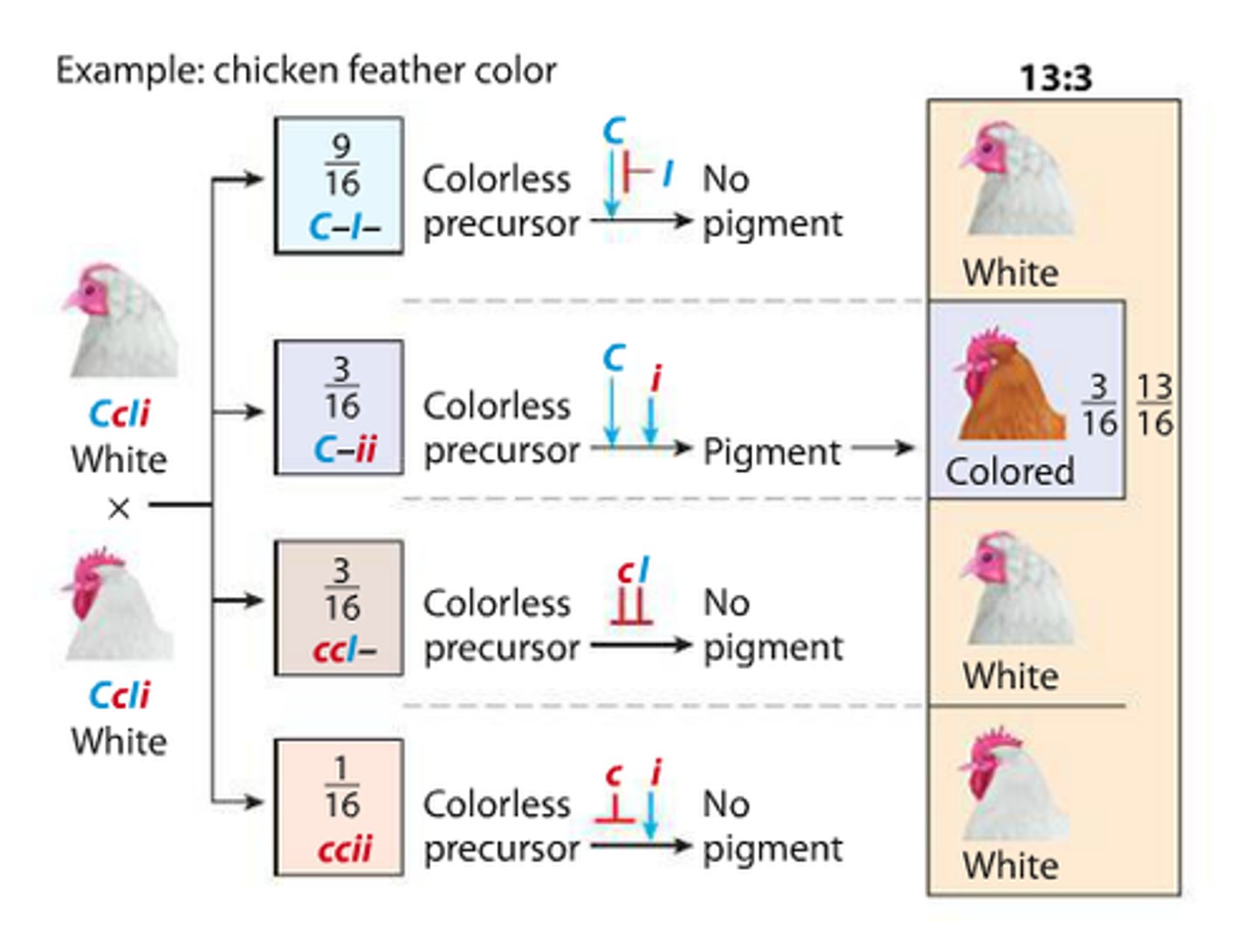
Extranuclear Inheritance/Organellar Inheritance
the transmission of genetic material located outside the nucleus primarily the mitochondria and chloroplasts; usually inherited exclusively through mother
Mitochondrial Inheritance
The transmission of the mitochondrial genome from mother to child; not mendelian
Somatic Segregation
when cells divide the organelles are randomly divided into daughter cells; if the cell is heteroplasmic then the daughter cell may be either heteroplasmic or homoplasmic
Homoplasmy
all mitochondria have the same genotype (all organellar DNA is identical)
Heteroplasmy
mitochondria have different genotypes (mixture of organellar DNA)
Severity of Mitochondrial Disease
heteroplasmy -- mix of normal and mutated DNA affects the severity
Mitochondrial Disorder from Pedigree
transmission only through maternal line but can show up in either sex
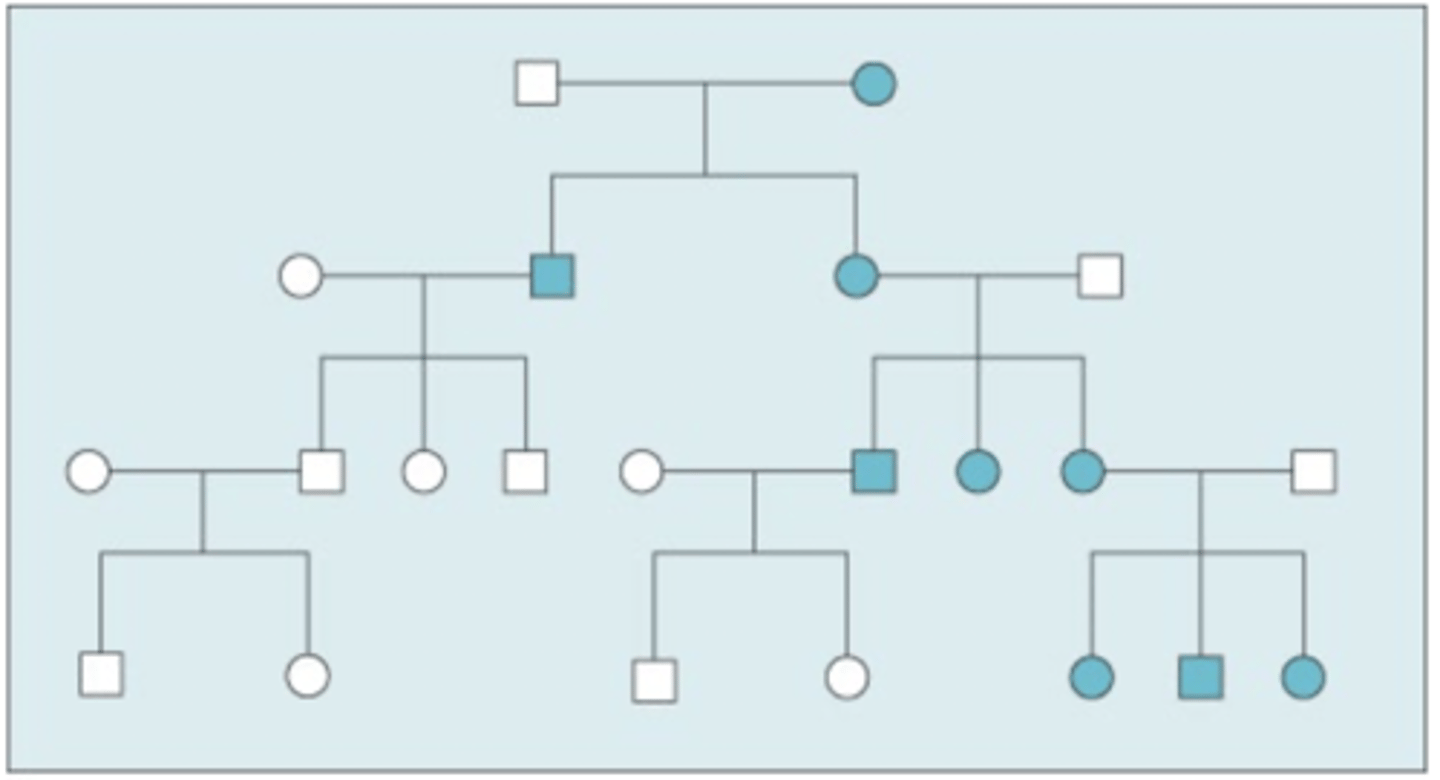
Dosage Compensation in Human Females
X-Inactivation -- in females one of the two X chromosomes is inactivated in each cell (males only have one X so the inactivation is to equalize the protein amount encoded -- females would have double due to XX); Barr body contains the inactivated X chromosome
Dosage Comp in Flies and Worms
Flies -- Hyperactivation - the single X in males is upregulated to double its activity to match female XX gene expression (increase transcription)
Worms -- Hypoactivation - the activity of XX is down regulated by half so the gene expression equals that of males (decrease transcription)
All Women are Mosaics
Inactivated X chromosome condensed into Barr body -- sometime maternal X and sometimes paternal X -- random inactivation creates a mosaic pattern where different cell populations express genes from either the maternal or paternal X chromosome
Calico Cat Example
X chromosome has 2 alleles, one for orange fur, one for black fur, go through cell division and X chromosome inactivation, different cells activate different genes; Some cells activate orange while some activate black; only really happens in females, the Barr bodies inactivate one color so you get patches of maternal and paternal coloration (white patches cause by spotting gene); split color faces -- chimerism - fusion of twins early, mitotic non-disjunction
Allele and Genotype Frequency
genotype frequency -- # of genotype/ total
allele frequency -- # of alleles (A1 or A2 in all genotypes)/total # of alleles
Hardy Weinberg
1 = p^2 +2pq + q^2; p^2 --> homozygous dominant allele pair frequency; q^2 --> homozygous recessive allele pair frequency; 2pg --> heterozygous allele frequency; assumes population is large, randomly mating, not affected by mutation, migration, or natural selection --> allelic frequencies don't change and the genotypic frequencies stabilize; p +q = 1 --> allele frequency
Reproductive Isolation
Separation of species or populations so that they cannot interbreed and produce fertile offspring --> can lead to new species or maintain species; prezygotic - block eggs fertilization (spacial isolation, seasonal isolation, behavioral isolation, mechanical isolation) and postzygotic - block next gen's fertility (offspring doesn't mature, sterility, F1 gen fertile but F2 gen sterile)
Speciation
allopatric speciation - geographic separation
sympatric speciation - speciation with no geographic isolation (reproductive isolation)
4 Species Concepts
biological (interbreed and fertile offspring), morphological (same structure e.g. fossils), recognition (recognizes a fertile mate), phylogenetic (matching DNA sequences)
Phylogenetic Tree Applications
more similar nucleotide sequence --> more recent common ancestor; examine viral transmission between individuals --> sequence viral DNA and compare to form tree that shows transmission path
Examples of Human-Dog Coevolution/Common Ancestry
Eye contact results in mutual release of oxytocin; humans can differentiate dog barks; domestication achieved through selection affects other traits; dogs share a lot of DNA with people --> similar genetic disorders, sequenced dog genome --> dogs are simpler than humans to study but have enough overlap that their genetic information can inform our knowledge about humans
CRISPR
gene editing technique; a collection of DNA sequences that tells Cas9 exactly where to cut; a guide RNA finds a specific DNA sequence that the enzyme Cas9 cuts followed by natural DNA repair where the gene can be disabled by letting the cell repair the DNA in a messy way or a new piece of DNA can be inserted; basic cut and repair editing often silences the gene
Possible Modifications to CRISPR Function
Edit genes by replacing/adding sequences; sickle cell disease and cancer immunotherapy; reversible CRISPR method -- Cas9 is modified to just sit on the gene and not cut it -- can attach molecules to the Cas9 that either block or boost gene activity
Pros and Cons of Changing Genomes
Pros -- targeted medicines, biofuels, agriculture, industrial products
Cons -- safety, ethical concerns, regulatory challenges, lack of diversity in reference genomes for treatment development
Other Gene Editing
somatic gene editing -- just change the body's cells -- the edited gene only affects a specific cell type and isn't passed on (very researched and regulated)
germline gene editing -- all cells are changed and will be passed on (newer method)